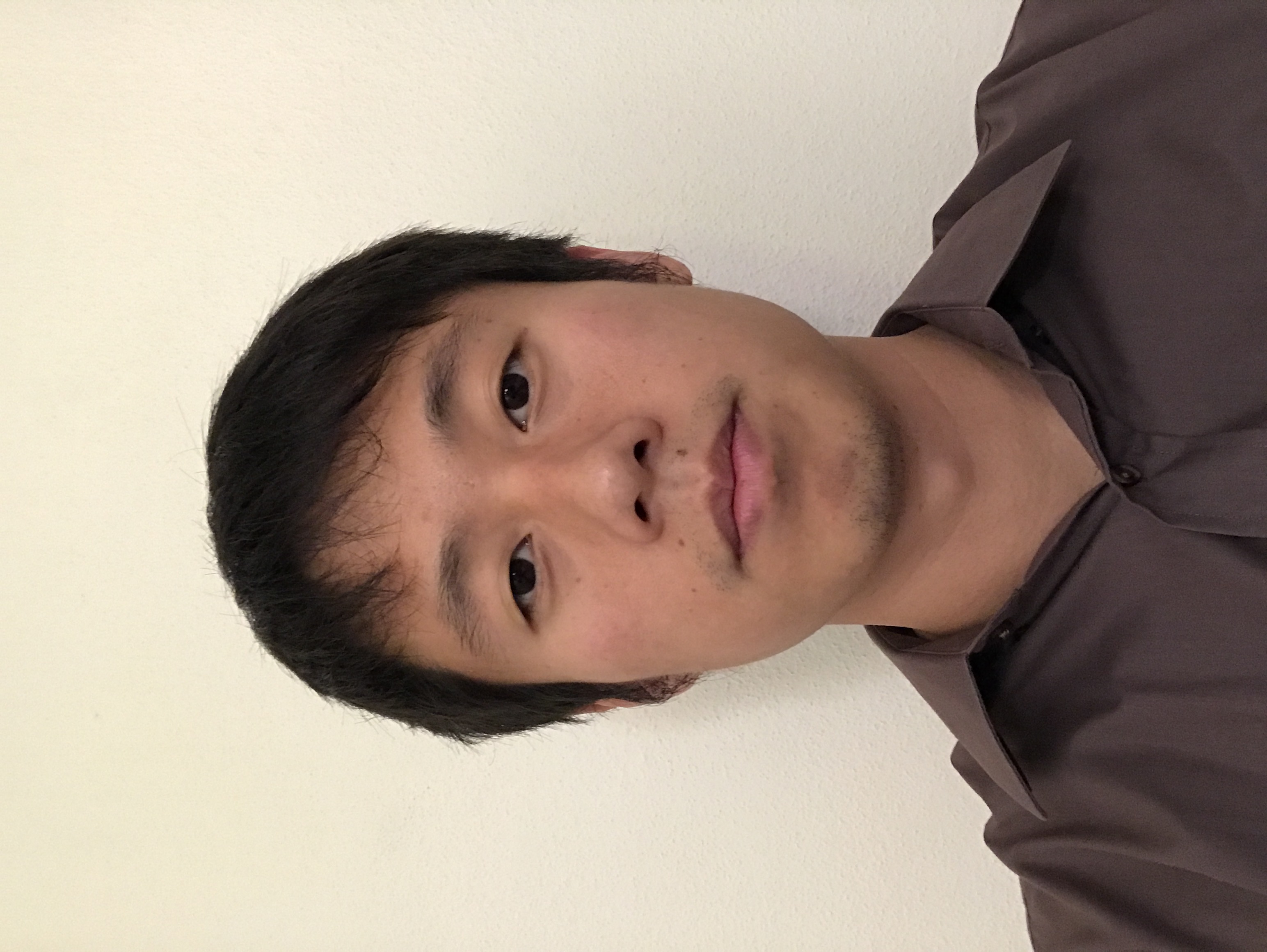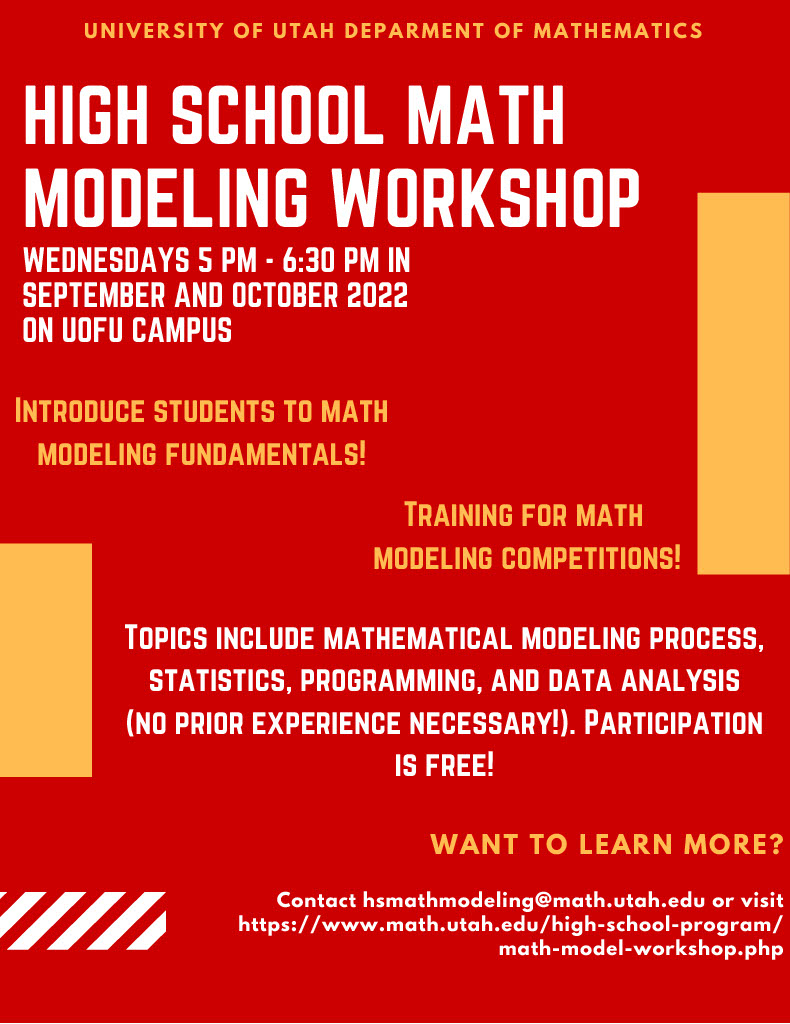University of Utah Math Modeling Workshop
Can roads be designed to reduce road rage? Where are the optimal locations for ambulance dispatches so that the greatest number of people are served in the least amount of time? How do infectious diseases spread and what are the most effective containment mechanisms?
In the Fall 2022 Math Modeling Workshop, students will be introduced to the fundamental ideas of mathematical modeling that can be used to tackle the three questions just posed (and more!). Particular topics include the mathematical modeling process, basic statistical ideas, as well as programming and doing data analysis in Python (no prior experience necessary!).
During this workshop students will have the opportunity to work in small groups to practice developing models to real world problems, as well as gain valuable experience presenting their models by writing up and presenting their work to their peers.
Students that take part in this workshop will be well prepared for two national math modeling competitions: (1) the High school Mathematical Competition in Modeling (HiMCM), a two-week long competition in November 2022, and (2) the Mathworks Math Modeling (M3) Challenge, a day-long competition that takes place in February 2023; students are welcome to attend without the intent of competing.
More about the HiMCM can be found on the COMAP website: https://www.comap.com/highschool/contests/himcm/index.html
More about the M3 Challenge can be found on the SIAM website: https://m3challenge.siam.org
There is no cost to take part in this workshop.
An information session was held on Wednesday, August 31st at 6pm, to give an overview of this workshop. The slides that were shown during the session can be found here.
After registering, you will receive a confirmation email containing information about joining the meeting.
2022 University of Utah Department of Mathematics
Math Modeling Workshop
Times and location
Program dates: September 7 - November 2, 2022
Program time: Wednesday, 5:00PM-6:30PM
Program location: Leroy Cowles Building (LCB), University of Utah, Room TBD
- Registration is currently open for Fall 2022!
- Intended audience: high school students, and motivated middle school students. The M3 Challenge is open to juniors and seniors, HiMCM is open to any high school students, and the HiMCM and MiMCM (middle school version) are open to middle school students.
- To register: please fill out this form to register for this workshop. Complete the Liability Waiver , Computer Use Policy, and Photo/Video Release forms. Email the pdf forms to hsmathmodeling@math.utah.edu.
The workshop will meet once a week for 1.5 hours (except during university holidays). Generally the workshop will be split into two parts, with a short break in the middle:
- Group Work (~1 hour): students break into teams and practice developing models/brainstorming
approaches, or analyze winning solutions to previous competitions.
- Since 1 hour is not much time to dive in deep with a problem, early problem solving sessions will focus on brainstorming approaches and developing a plan for if they had more time to work on the same problem. Later problem solving sessions (maybe after Fall break) may focus on the same problem across multiple weeks, to help prepare students for the HiMCM.
- Only one or two solution analysis sessions will be run during this workshop. These sessions are designed to expose students to what winning solutions look like, and identify best practices (in terms of modeling and writing). After later sessions, solutions will be given to students to read on their own time if they wish.
- Active lecture (~0.5 hours): Aspects of math modeling, programming/data analysis, statistics, etc. Designed to introduce students to core topics in math modeling as they become relevant during Group Work
- Students will be able to apply general modeling principles to real world problems:
- Defining the mathematical problem statement, making assumptions, and defining variables,
- Building the model,
- Analyzing and assessing the model.
- Students will use Excel spreadsheets and programming to analyze data and run simulations to develop and support their mathematical models.
- Students will be able to apply basic statistical tools and tests to support their models.
- Students will be able to read, analyze, and identify strong aspects of model reports. As a case study, students will analyze winning solutions to previous HiMCM and M3 competitions and compare and contrast the models different teams implemented.
- Students will utilize good writing and presentation practices to report their models to peers.
- Week 1: an overview of the math modeling process, along with a guided problem solving session to help students get comfortable with the math modeling process.
- Week of Sep. 5 - Sep. 9
- Active Lecture: An introduction to the math modeling process, with case studies.
- Group Work: A scaffolded problem solving activity, where students break into groups and tackle a previous competition problem with guidance from leading questions and volunteers.
- Week 2: an introduction to Programming, winning report analysis for Week 1’s problem.
- Week of Sep. 12 - Sep. 16
- Active Lecture: An introduction to basic programming and programming principles.
- Group Work: Students are provided copies of winning solutions for the problem from Week 1, and asked to skim the solutions for things that are “good”. Guiding questions are provided.
- Week 3: an introduction to data analysis in Python and excel.
- Week of Sep. 19 - Sep. 23
- Active Lecture: An introduction to data, data types, and effectively using Excel and programming to analyze data.
- Group Work: A (slightly less) scaffolded problem from a previous competition that made heavy use of data; said data will be provided.
- Week 4: Sensitivity analysis
- Week of Sep. 26 - Sep. 30
- Group Work: Time to work on further parts of last week’s problem; perhaps shuffling groups to increase spread of ideas
- Active lecture: A discussion of ways to measure error, and measure “stability” of models.
- Week 5: An introduction to difference and differential equations
- Week of Oct. 3 - Oct. 7
- Group Work: A (slightly less) scaffolded problem from a previous competition, whose winning solutions generally incorporated differential equations.
- Active Lecture: An introduction to the SIR disease spread model, difference equations, and differential equations. No calculus background will be required.
- Week 6: FALL BREAK
- Week of Oct. 10 - Oct. 14
- Week 7: linear regression and other statistical ideas
- Week of Oct. 17 - Oct. 21
- Group Work: Time to work on further parts of Week 5’s problem.
- Active Lecture: An introduction to linear regression, correlation, and some other fundamental statistical ideas that are important in model assessment.
- Week 8: writing the report
- Week of Oct. 24 - Oct. 28
- Group Work: Analysis of winning solutions to Week 5’s problem.
- Active lecture: An overview of typesetting softwares, as well as good writing (organization, grammar, etc.) practices.
- Week 9: contest starts! (no meeting)
- SIAM has free workbooks on Mathematical Modeling available on their website.
- Resources from a previous iteration of this workshop can be found here.
- An entirely online introduction to Python can be found at W3 schools (via the “Try it yourself” sections).
- An introduction to Google Colab notebooks and their Python environment can be found here.
For more information about the program, please contact: hsmathmodeling@math.utah.edu



